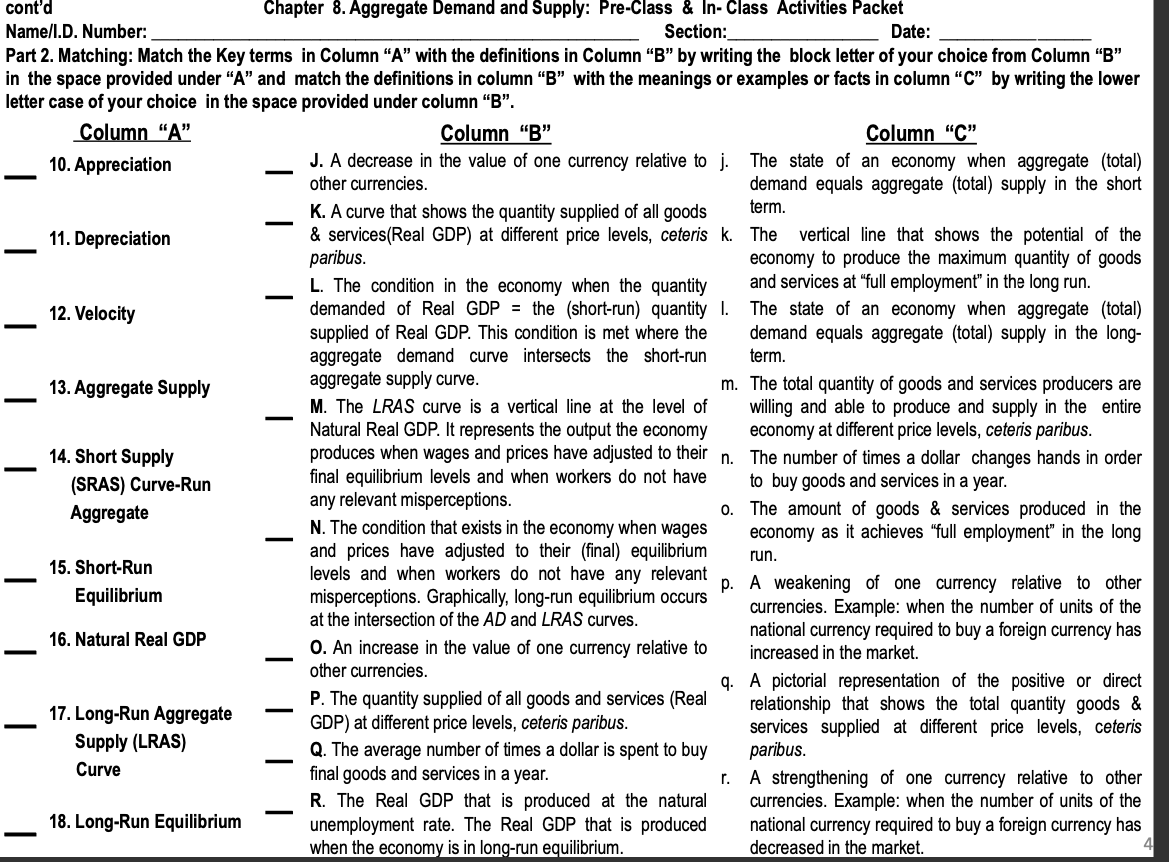I want only answers to questions # 11, 13, 15, 17. Thank you.
oont'd Namell.D. Number: cull lmn il a H 10. Appreciation 11. Depreciation 12. Velocity 13. Aggregate Supply 14. Short Supply {SRAS} Curve-Run Aggregate 15. Short-Run Equilibrium 16. Natural Real GDP 17. Long-Run Aggregate Supply iLRAS} Curve 18. Long-Run Equilibrium Section: Part 2. Matching: Match the Key terms In Column \"A" with the denitions in Column \"B" by writing the block letter of your choice from Column \"B\" in the space provided under "A\" and match the denitions in column \"B" with the meanings or examples or facts in column \"B\" by writing the lower letter case of your choice in the space provided under column \"B". Column "B\" J. A decrease in the value of one currency relative to j. other currencies. K. A curve that shows the quantity supplied of all goods 8. services(Real GDP) at different price levels, ceteris paribus. L. The condition in the economy when the quantity demanded of Real GDP = the (short-nin} quantity supplied of Real GDP. This condition is met where the aggregate demand curve intersects the short-nin aggregate supply curve. lit. The LRAS curve is a vertical line at the level of Natural Real GDP. It represents the output the economy produces when wages and prices have adjusted to their nal equilibrium levels and when workers do not have any relevant misperceptions. N. The condition that exists in the economy when wages and prices have adjusted to their (nal) equilibrium levels and when workers do not have any relevant mispercepticns. Graphically, long-nin equilibrium occurs at the intersection of the AD and LRAS curves. 0. An increase in the value of one currency relative to other currencies. P. The quantity supplied of all goods and services (Real GDP) at different price levels, cereals periods. 0. The average number of times a dollar is spent to buy nal goods and services in a year. R. The Real GDP that is produced at the natural unemployment rate. The Real GDP that is produced when the econom is in Ion nine uilibrium. l. Chapter 8. Aggregate Demand and Supply: Pie-Class & ln-Class Activities Packet Date: Column \"C\" The state of an economy when aggregate (total) demand equals aggregate (total) supply in the short term. The vertical line that shows the potential of the economy to produce the maximum quantity of goods and services at \"full employment\" in the long run. The state of an economy when aggregate (total) demand equals aggregate (total) supply in the long- term. The total quantity of goods and services producers are willing and able to produce and supply in the entire economy at different price levels, ceten's periods. The number of times a dollar changes hands in order to buy goods and services in a year. The amount of goods it services produced in the economy as it achieves \"full employment\" in the long run. A weakening of one currency relative to other currencies. Example: when the number of units of the national currency required to buy a foreign currency has increased in the market. A pictorial representation of the positive or direct relationship that shows the total quantity goods 8: services supplied at different price levels, ceterr's perilous. A strengthening of one currency relative to other currencies. Example: when the number of units of the national currency required to buy a foreign currency has decreased in the market







